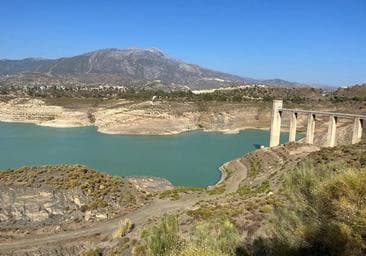Malaga needs to triple quantity of water in its reservoirs across the province to overcome current drought crisis
The head of Spain's state weather agency in the area, Jesús Riesco, has warned, "we are now entering a period in which it is highly improbable that the drought situation can be ended by the summer"
Chus Heredia
Wednesday, 6 March 2024
The Drought Plan for the Mediterranean Basins, to which Malaga province, including the Costa del Sol, belongs, was approved in May 2021 and the drought has been official for three years already. Spain's state Met Office, Aemet, has now explained what needs to happen for the situation to improve before the long, hot and dry summer arrives.
Across the province, the hydrographic response varies from area to area, but an estimate would place the required water reserves at more than 250 cubic hectometres (the storage capacity is 611.48 cubic hectometres (hm³). This is practically three times higher than the current level of the reserves if the El Limonero and Casasola reservoirs are excluded as these do not supply water but act as defensive systems to prevent flooding.
Right now, without both the El Limonero and Casasola reservoirs, the province has 87 cubic hectometres. But it should be made clear that the drought is determined by the levels of reserves in the various districts. Each of these enters and leaves the phases at different times. The Axarquía was the first to reach a serious level, followed by the Costa del Sol and, finally, Malaga city and the Guadalhorce valley.
Guadalhorce-Limonero
In the Guadalhorce-Limonero system, the reserves of the Conde de Guadalhorce, Guadalteba, Guadalhorce and Limonero reservoirs hold the main reserves for the province. The threshold set by the Drought Plan is 71.4hm³. Below this threshold, the level is deemed 'serious'. To get out of this current situation, it is necessary to gain eight hectometres, which is the amount of water required by Malaga city to last two months.
But to avoid moderate drought, it is necessary to gain 77hm³, for which the reservoirs would have to collect the equivalent of almost two years’ of consumption. Finally, to avoid any drought, which will take years, the volume of water collected must exceed 205hm³.
Dizzying figures in the Axarquía
In the Axarquía, the hydrological mathematics are very worrying. The large reservoir at La Viñuela now stores 13.4hm³, according to data from the Hidrosur network on Tuesday. To get out of the severe drought situation, the reservoir would have to more than triple its water and exceed the threshold of 41.5 hm³.
Costa del Sol, highly variable thresholds
What happens in the Costa del Sol area? Here the calculations are much more variable. There is the added factor of the Marbella desalination plant, which can provide 20% of the annual consumption in the area, and, of course, there are very marked fluctuations in the floating population depending on the tourist season. Right now, La Concepción reservoir, the main source of supply for the Costa del Sol, has 15.15hm³. To breathe a little more easily and move away from the current severe drought situation, it would have to exceed an increase of between 19 and 23 hm³, depending on the month. It is necessary to at least double the current reserves.
Aemet, cautious but clear: March is the last chance for a rainy season
The head of Spain's state weather agency in the province, Jesús Riesco, has warned, "we are now entering a period in which it is highly improbable that the drought can end by the summer".
"It's very complicated to know how much it should rain. We've had a long-lasting drought” and Riesco said it not only needs to rain well above the normal average values, but also next year too.
The margin between now and summer is practically non-existent. "From October to February, the good months have passed. March is still a favourable time but we are now entering a period in which it is highly improbable that the drought can be ended by the summer," the weather expert said.
Junta contracts a four-year monitoring system
The Junta de Andalucía regional government, through the regional ministry of Agriculture, has put out to tender a contract valued at almost 3.5 million euros for the coordination, monitoring and review of the Hydrological Plans and the Drought Plans. The development of the plan is for four years, so administratively there is little confidence in overcoming the current situation in less than four years. This was the case during the 2005 drought, the official settlement of which took place on 5 February 2009, when Malaga and the Guadalhorce exceeded the threshold of 160 cubic hectometres set at the time.

